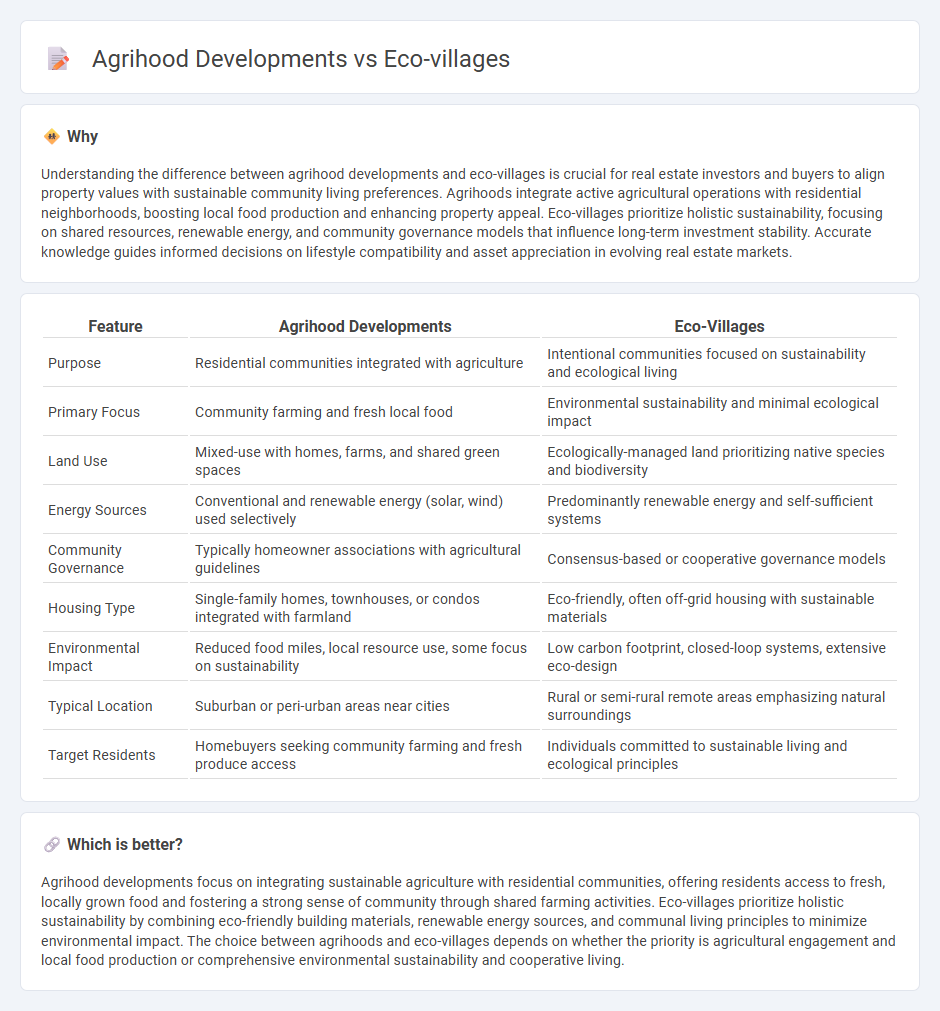
Agrihood developments integrate sustainable farming practices with residential living to create communities centered around agriculture, promoting local food production and environmental stewardship. Eco-villages focus on holistic sustainability, emphasizing renewable energy, low-impact housing, and cooperative living to reduce ecological footprints. Discover the key differences and benefits of these innovative real estate trends.
Why it is important
Understanding the difference between agrihood developments and eco-villages is crucial for real estate investors and buyers to align property values with sustainable community living preferences. Agrihoods integrate active agricultural operations with residential neighborhoods, boosting local food production and enhancing property appeal. Eco-villages prioritize holistic sustainability, focusing on shared resources, renewable energy, and community governance models that influence long-term investment stability. Accurate knowledge guides informed decisions on lifestyle compatibility and asset appreciation in evolving real estate markets.
Comparison Table
| Feature | Agrihood Developments | Eco-Villages |
|---|---|---|
| Purpose | Residential communities integrated with agriculture | Intentional communities focused on sustainability and ecological living |
| Primary Focus | Community farming and fresh local food | Environmental sustainability and minimal ecological impact |
| Land Use | Mixed-use with homes, farms, and shared green spaces | Ecologically-managed land prioritizing native species and biodiversity |
| Energy Sources | Conventional and renewable energy (solar, wind) used selectively | Predominantly renewable energy and self-sufficient systems |
| Community Governance | Typically homeowner associations with agricultural guidelines | Consensus-based or cooperative governance models |
| Housing Type | Single-family homes, townhouses, or condos integrated with farmland | Eco-friendly, often off-grid housing with sustainable materials |
| Environmental Impact | Reduced food miles, local resource use, some focus on sustainability | Low carbon footprint, closed-loop systems, extensive eco-design |
| Typical Location | Suburban or peri-urban areas near cities | Rural or semi-rural remote areas emphasizing natural surroundings |
| Target Residents | Homebuyers seeking community farming and fresh produce access | Individuals committed to sustainable living and ecological principles |
Which is better?
Agrihood developments focus on integrating sustainable agriculture with residential communities, offering residents access to fresh, locally grown food and fostering a strong sense of community through shared farming activities. Eco-villages prioritize holistic sustainability by combining eco-friendly building materials, renewable energy sources, and communal living principles to minimize environmental impact. The choice between agrihoods and eco-villages depends on whether the priority is agricultural engagement and local food production or comprehensive environmental sustainability and cooperative living.
Connection
Agrihood developments and eco-villages are connected through their focus on sustainable living and community-centered design, integrating residential spaces with agriculture and green infrastructure. Both promote local food production, reducing carbon footprints, and fostering eco-friendly lifestyles by combining natural landscapes with modern housing. This synergy supports environmental stewardship while enhancing quality of life for residents through access to farm-to-table resources and shared green spaces.
Key Terms
Sustainability
Eco-villages prioritize holistic sustainability by integrating renewable energy, permaculture, and community-driven resource management to minimize environmental impact. Agrihood developments emphasize sustainable agriculture practices, local food production, and green space preservation within suburban residential settings. Discover how these innovative models reshape sustainable living and enhance ecological resilience.
Community Agriculture
Eco-villages and agrihood developments emphasize community agriculture by integrating sustainable farming practices and shared green spaces that promote local food production and environmental stewardship. Eco-villages often prioritize holistic living and ecological balance, whereas agrihoods focus on residential neighborhoods centered around active agricultural operations. Explore the benefits and distinctions of these innovative community agriculture models to find the ideal sustainable living solution.
Green Infrastructure
Eco-villages prioritize green infrastructure by integrating renewable energy systems, natural water management, and habitat restoration to create self-sustaining communities centered on environmental stewardship. Agrihood developments emphasize urban agriculture combined with green spaces such as rain gardens and permeable pavements to enhance ecosystem services and food security within suburban settings. Explore the innovative approaches these models use to foster resilient, sustainable living environments.
Source and External Links
Ecovillages From Around the World for Sustainable Living - This article highlights various ecovillages worldwide, featuring their innovative approaches to sustainability, such as the Global Ecovillage Network's efforts to promote environmentally friendly practices.
5 of the World's Coolest EcoVillages - This piece showcases some of the world's most notable ecovillages, including Findhorn EcoVillage in Scotland, known for its sustainable architecture and low carbon footprint.
Ecovillage - Wikipedia defines ecovillages as communities that strive for sustainability through environmental stewardship, social cohesion, and economic self-sufficiency, utilizing practices like renewable energy and organic agriculture.
 dowidth.com
dowidth.com